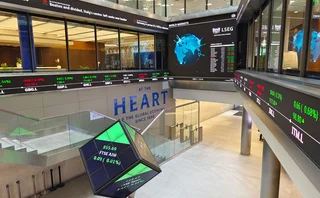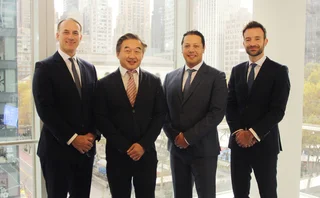
Corporate risk manager of the year: Ford Motor Company
Natural hedges and holistic analysis help auto giant cut hedging costs

Risk Awards 2016
Five years ago, Ford Motor Company set out to develop a more fuel-efficient version of its flagship pick-up truck, the Ford F-150. The result is an aluminium-bodied 2015 model that is lighter, safer and uses about 25% less fuel than its predecessor.
The company's treasury department seems to have taken these achievements to heart. In recent years, in an attempt to manage risk more efficiently, it has pulled different exposures together, enabling it to analyse and hedge the net risk.
"Prior to the financial crisis, risk management activities, such as currency and interest rate hedging, were done by separate treasury departments," says Brian Schaaf, an assistant treasurer at Ford's corporate headquarters in Dearborn, Michigan, on the outskirts of Detroit. "Now, these hedging activities have been consolidated into a single treasury risk management function, and we're approaching it with a more holistic focus on the macro environment, risk relationships and potential strategic implications for the business."
The consolidated treasury risk management function's toolkit has also been upgraded. Stress testing, scenario planning and sensitivity analysis now play a bigger role in decision-making, and new risk models have given a better understanding of the correlations and diversification benefits across portfolio exposures.
"As a result, hedging strategies have been developed to achieve the same risk reduction with lower cost and the use of fewer derivatives," says Schaaf.
The new and improved treasury function has a bigger voice in the boardroom too. As one example, treasury analysis of the Ford's foreign exchange exposures is being factored into big, strategic decisions, such as the location of assembly plants – where natural hedges can be achieved by manufacturing and selling in the same currency, the benefits are taken into account.
"Historically, Ford has managed foreign exchange risk associated with each currency exposure on an independent basis. Recently, we've developed a portfolio view of foreign exchange exposures across the company to assess and manage risk more holistically," says Schaaf. "In addition to supporting hedging strategies, this also provides a management framework to support longer-term strategic decisions that can influence the exposure profile over time. This framework, combined with scenario analysis capabilities, has enhanced foreign exchange understanding and integration into operating decisions."
We've developed a portfolio view of foreign exchange exposures across the company to assess and manage risk more holistically
Brian Schaaf, Ford
Currency hedging has taken on greater significance as Ford's sales have surged in Asia, with more than one million vehicles sold in China in 2015, beating the company's own forecasts. As sales have risen, so has the company's exposure to Asian currencies, and its decision to build assembly plants in China and India last year was partly motivated by a desire to reduce currency hedging costs.
The treasury group has made a concerted effort to establish stronger relationships with local banks in developing countries, which now play a bigger role in its hedging activity than at any time in its history.
"As our business has expanded into new and emerging markets, local relationships have played a larger role in the delivery of currency hedging programmes. Local teams provide efficient access in regulated markets, as well as a practical on-the-ground perspective and assistance in navigating local practices, market conventions and regulations," says Schaaf.
The new and improved corporate treasury department made an important contribution to the success of Ford's long-term strategy of building more fuel-efficient vehicles with more aluminium parts than previously. The firm's demand for the metal has trebled in the past two years following the roll-out of vehicles such as the Ford F-150. At the same time, the cost of aluminium has plunged from a five-year peak of $2,667 per metric tonne in April 2011 to only $1,497 last December.
The corporate treasury risk management team jumped on the chance to lock in the low prices. "Ford is increasingly using aluminium to reduce vehicle weight and improve fuel economy. The increased exposure has created a need to increase commodity price risk management," says Schaaf.
The company employed several strategies to do this – hedging the cost of aluminium in the futures markets or with banks, or entering into contracts that pass on this risk to suppliers. These efforts will ensure Ford is churning out F-150s and other aluminium-bodied vehicles for years to come.
Only users who have a paid subscription or are part of a corporate subscription are able to print or copy content.
To access these options, along with all other subscription benefits, please contact info@risk.net or view our subscription options here: http://subscriptions.risk.net/subscribe
You are currently unable to print this content. Please contact info@risk.net to find out more.
You are currently unable to copy this content. Please contact info@risk.net to find out more.
Copyright Infopro Digital Limited. All rights reserved.
As outlined in our terms and conditions, https://www.infopro-digital.com/terms-and-conditions/subscriptions/ (point 2.4), printing is limited to a single copy.
If you would like to purchase additional rights please email info@risk.net
Copyright Infopro Digital Limited. All rights reserved.
You may share this content using our article tools. As outlined in our terms and conditions, https://www.infopro-digital.com/terms-and-conditions/subscriptions/ (clause 2.4), an Authorised User may only make one copy of the materials for their own personal use. You must also comply with the restrictions in clause 2.5.
If you would like to purchase additional rights please email info@risk.net
More on Awards
Clearing house of the year: LCH
Risk Awards 2025: LCH outshines rivals in its commitment to innovation and co-operation with clearing members
Best use of machine learning/AI: CompatibL
CompatibL’s groundbreaking use of LLMs for automated trade entry earned the Best use of machine learning/AI award at the 2025 Risk Markets Technology Awards, redefining speed and reliability in what-if analytics
Markets Technology Awards 2025 winners’ review
Vendors jockeying for position in this year’s MTAs, as banks and regulators take aim at counterparty blind spots
Equity derivatives house of the year: Bank of America
Risk Awards 2025: Bank gains plaudits – and profits – with enhanced product range, including new variants of short-vol structures and equity dispersion
Law firm of the year: Linklaters
Risk Awards 2025: Law firm’s work helped buttress markets for credit derivatives, clearing and digital assets
Derivatives house of the year: UBS
Risk Awards 2025: Mega-merger expected to add $1 billion to markets revenues, via 30 integration projects
Interest rate derivatives house of the year: JP Morgan
Risk Awards 2025: Steepener hedges and Spire novations helped clients navigate shifting rates regime
Currency derivatives house of the year: UBS
Risk Awards 2025: Access to wealth management client base helped Swiss bank to recycle volatility and provide accurate pricing for a range of FX structures







